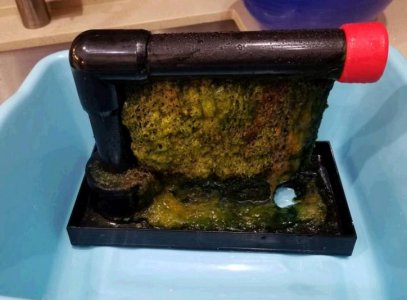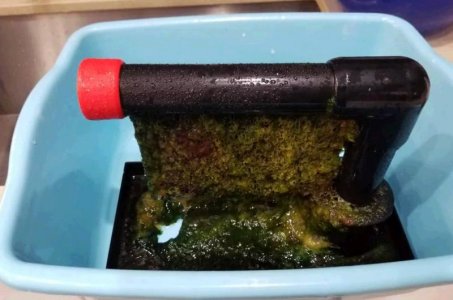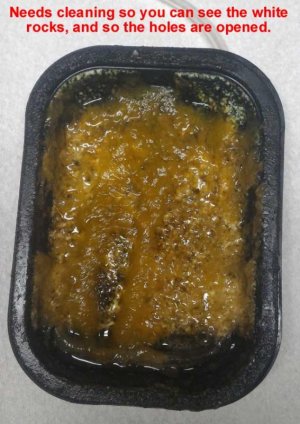You are using an out of date browser. It may not display this or other websites correctly.
You should upgrade or use an alternative browser.
You should upgrade or use an alternative browser.
Algae Scrubber Basics
- Thread starter srusso
- Start date
SantaMonica
Well-known member
A few people do. It will work if nutrients in the water are very high, because the dark growth needs the most light. Also in freshwater it can usually be done.
Best though is to start with 18 hours.
Best though is to start with 18 hours.
A few people do. It will work if nutrients in the water are very high, because the dark growth needs the most light. Also in freshwater it can usually be done.
Best though is to start with 18 hours.
18 hrs would be optimum for algea to grow?
Sent from my iPhone using Tapatalk
SantaMonica
Well-known member
For scrubbers, it's more about color and thickness of the growth. Since you don't know what the growth will be, you start at 18. If it's black slime and blocks light, you add more. If it light yellow, you reduce intensity.
Scrubber_steve
I'm really very likeable
Thank you.
Do algea need some time without a light ? Corals need some time with no light.
macro algae, no in general. Ive run mine 24/7 using LED. The ulva was not negatively affected at all. The growth increased & NO3 fell to zero.
In general the longer the illumination period the greater inorganic nutrient export.
If I were you I would find the Goldi Locks illumination duration you need to get the level of NO3 you want. In other words, if you want higher NO3 levels, run the illumination for a shorter period of time. If your NO3 is higher than you want it, increase the illumination duration until you reach your target no3.
Red 660nm
And remember that dark green slime removes more nutrients from the water, per gram, than GHA. You just need to use a brush for cleaning, and do it more often.
do you think Red is better then white (3-4 K )?
Joe from 302 Aquatics swears that white better then only red...HMMMMM:eek2:
SantaMonica
Well-known member
Yes of course. It's well known that red is critical for photosynthesis, and for algae it's all that's needed because GHA attaches to the tops of rocks on reefs/beach where red is strong. Further deep, red goes away. So the best filtering at the surfaces gets strong red.
Anyone who uses white usually does so because the leakage of light into the room/sump is so much that any color would be intolerable; so they use white.
Anyone who uses white usually does so because the leakage of light into the room/sump is so much that any color would be intolerable; so they use white.
Scrubber_steve
I'm really very likeable
do you think Red is better then white (3-4 K )?
Joe from 302 Aquatics swears that white better then only red...HMMMMM:eek2:
This is the ulva growing on my scrubber screen under only 660nm LED.
IMO, the wattage used to generate other spectrums of light is not only a waste of electricity, but the other spectrums promote types of algae you don't want.
This is the ulva growing on my scrubber screen under only 660nm LED.
IMO, the wattage used to generate other spectrums of light is not only a waste of electricity, but the other spectrums promote types of algae you don't want.
Superior growth !
What type of LED do you use?
Sent from my iPhone using Tapatalk
Scrubber_steve
I'm really very likeable
Superior growth !
What type of LED do you use?
Sent from my iPhone using Tapatalk
I make my own using cree
SantaMonica
Well-known member
A rougher screen only helps. Especially on upflows and waterfalls, where there is more vertical pulling on the algae. It's the rapid air/water interface turbulence rubbing and pulling on the algae that give the best filtering.
Floyd R Turbo
Either busy or sleeping
That mortar idea on the screen a few pages back is ridiculous...Not a fan of roughing up the screen either...I've had plenty of horizontal scrubbers grow great algae without roughing up the screen . maybe it helps on the vertical...
Don't knock it until you try it. After making scrubbers for just over 8 years, I can tell you that it makes a major difference, at least on anything vertical. I can see how it would maybe not make that noticeable of a difference with horizontal, but that's related to the need for strength where the algae anchors to the substrate.
If you try a waterfall with a stock screen, then one with it roughed up lightly, then roughly up heavily, then a mortar coated screen, you will see the difference. I wouldn't recommend it if there wasn't an advantage to it.
The advantage to the mortar screen is the speed at which it populates. This can vary from tank-to-tank but in general, it allows the screen to start growing algae much faster. Then as the mortar detaches during harvesting, the exposed areas of the canvas start to fill in. This happens slower without the mortar, but once the algae has grown on the mortar and some screen is exposed, that exposed screen fills in faster since there is algae present already. Eventually 95% of the mortar is gone and you're left with about the same result in the long run. It's the short-run where it makes a difference.
Incidentally, going back to the attachment issue, when you have an open-air waterfall scrubber, the algae will attach very strongly. When you have a closed-box scrubber that is allowed to fill up with 3D growth, the algae will tend to anchor more weakly. That doesn't mean that it's going to detach and fall into your tank (depending on the design) but what I've seen happening is that the substrate becomes more of a "placeholder" for lack of a better term. The mat/mass of algae eases up on the "pulling" from the screen, and the result seems to be less "need to anchor" so it just doesn't...
The same could be the case for the horizontal, which is why there might be less of a need to rough up the screen.
Just some observations and thoughts...



